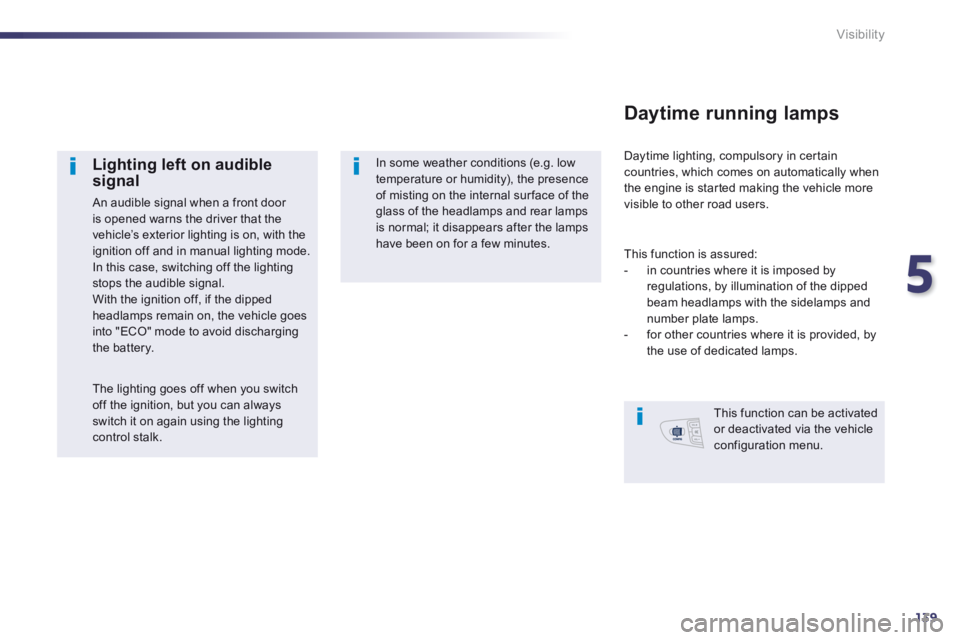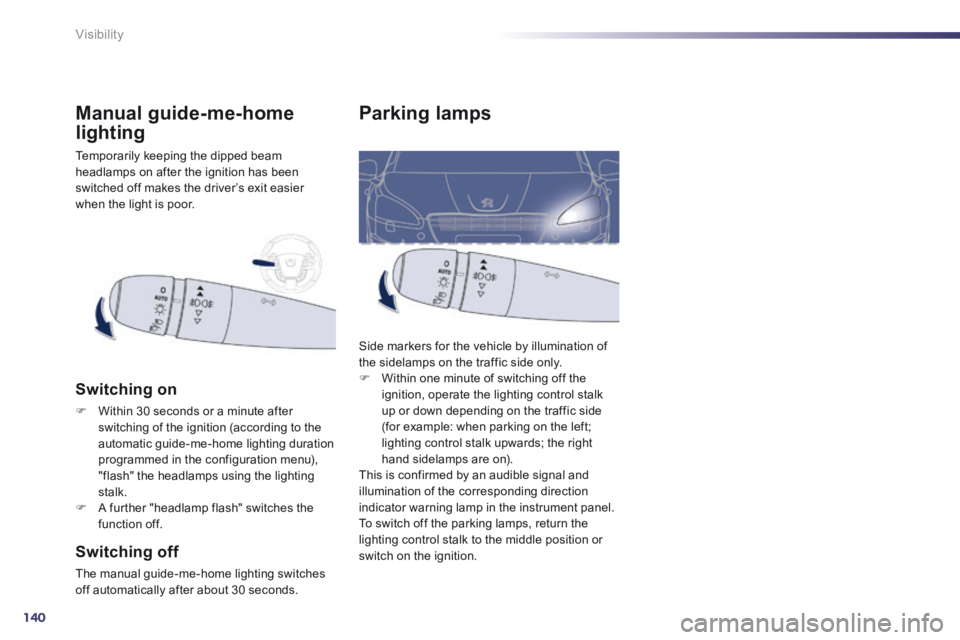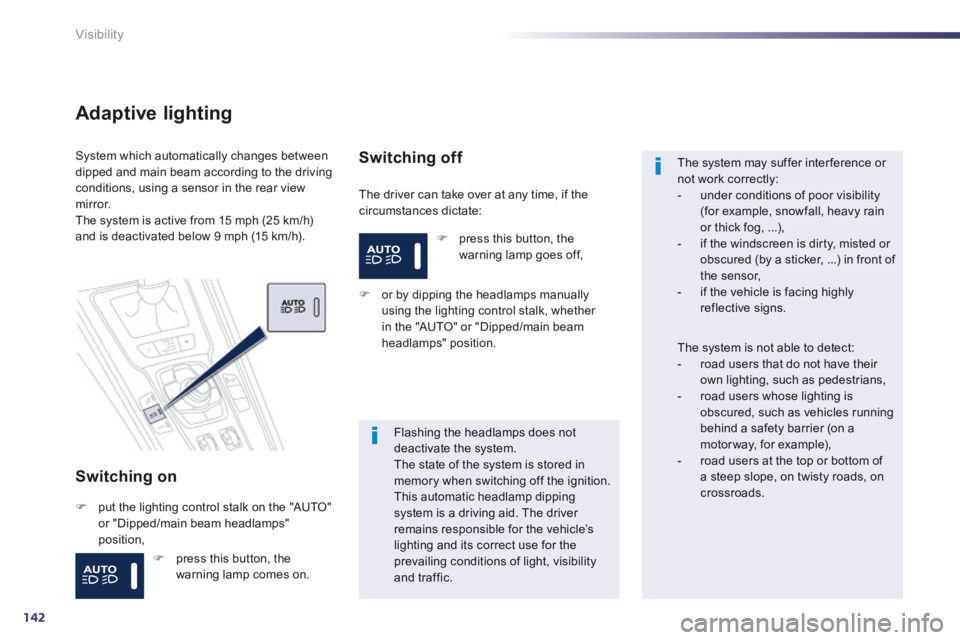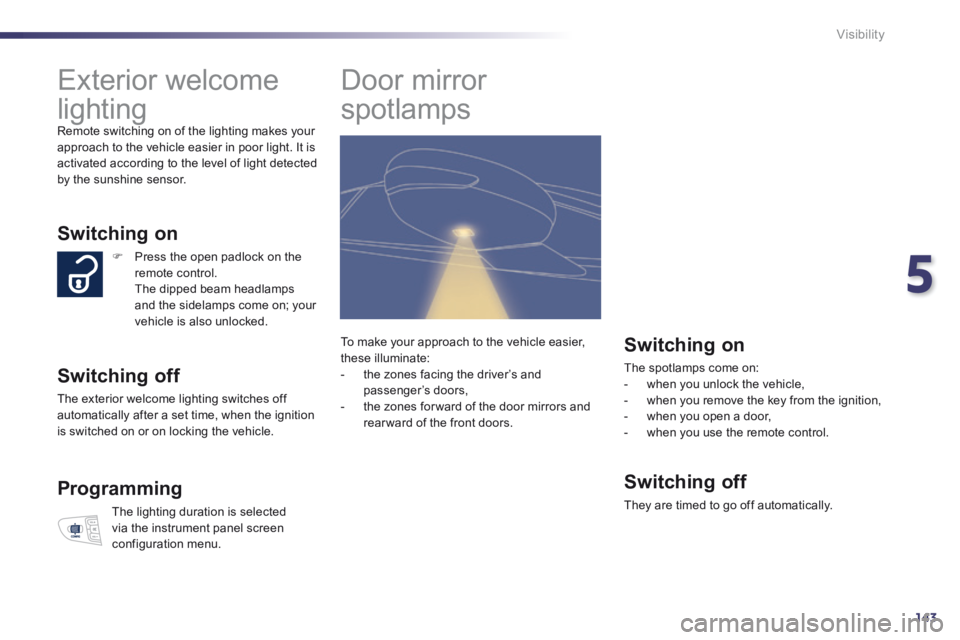Page 127 of 352
4
125
Driving
Head-up display
System which projects various information onto a smoked strip in the field of vision of the driver so that they do not have to take their eyes off the road.
1. Head-up display on. 2. Head-up display off (long press). 3. Brightness adjustment. 4. Display height adjustment.
Buttons
Once the system has been activated, the following information is grouped together in the head-up display: A. The speed of your vehicle. B. Cruise control/speed limiter information.
Displays during operation
C. Navigation information (according to ve r s i o n).
For more information on the navigation system, refer to the "Audio and telematic" section.
This system operates when the engine is running and the settings are stored when the ignition is switched off.
Page 130 of 352

128
Driving
Speed limiter
System which prevents the vehicle from exceeding the speed programmed by the driver. When the programmed speed limit is reached, pressing the accelerator pedal no longer has any effect unless it is pressed firmly, which allows you to temporarily exceed the programmed speed. To return to the programmed speed, simply slow down to a speed below the programmed speed by releasing the accelerator.
The speed limiter is switched on manually: it requires a programmed speed of at least 20 mph (30 km/h).
The speed limiter is switched off by manual switched off by manual switched offoperation of the control.
The programmed speed remains in the memory
when the ignition is switched off.
The speed limiter cannot, in any circumstances, replace the need to observe speed limits, nor can it replace the need for vigilance and responsibility on the part of the driver.
This information also appears in the head-up display. For more information, refer to the "Head-up display" section. 1. Speed limiter mode selection button 2. Programmed value decrease button 3. Programmed value increase button 4. Suspend/restore speed limiter (pause) 5. Speed limiter off button
Steering mounted controls
The programmed information is grouped together in the instrument panel screen.
Displays in the instrument
panel
A. Speed limiter on / pause indication B. Speed limiter mode selection indication C. Programmed speed value
Page 132 of 352

130
Driving
Cruise control
System which automatically maintains the speed of the vehicle at the value programmed by the driver, without any action on the accelerator pedal. The cruise control is switched on manually: it requires a minimum vehicle speed of 25 mph (40 km/h) and the engaging: - 4th gear or higher on a manual gearbox, - 2nd gear or higher on an electronic gear control gearbox or automatic gearbox, - position A on the electronic gear control gearbox or D on the automatic gearbox.
The cruise control is switched off manually switched off manually switched offor by pressing the brake or clutch pedal or on triggering of the ESC system for safety reasons.
It is possible to exceed the programmed speed temporarily by pressing the accelerator pedal. To return to the programmed speed, simply release the accelerator pedal.
Switching off the ignition cancels any programmed speed value.
1. Cruise control mode selection button 2. Speed programming / programmed value decrease button 3. Speed programming / programmed value increase button 4. Cruise control suspension / resume button (pause) 5. Cruise control off button
Steering mounted controls
The cruise control cannot, in any circumstances, replace the need to observe speed limits, nor can it replace the need for vigilance and responsibility on the part of the driver.
This information also appears in the head-up display. For more information, refer to the "Head-up display" section.
The programmed information is grouped together in the instrument panel screen.
Displays in the instrument
panel
A. Cruise control on / pause indication B. Cruise control mode selection indication C. Programmed speed value
Page 137 of 352

4
135
Driving
Operation
When you have identified a parking space: Engage a gear on a manual gearbox or put the gear lever in position A (electronic gear control gearbox) or in position D (automatic gearbox). Press button A to start the system. Operate the direction indicator on the side where the space is to be measured; a message is displayed and the warning lamp flashes to confirm that measurement is in progress. During measurement, go for ward the length of the space, at a speed less than 12 mph (20 km/h), to prepare for your manoeuvre. Once the measurement has been completed, the system informs you of the level of difficulty of the manoeuvre by a message in the multifunction screen accompanied by an audible signal.
The system displays one of the following messages:
Parking possible
Parking difficult
Parking not advised
If the lateral distance between your vehicle and the parking space is too great, the system may not be able to measure the space.
The system remains available after each measurement and can therefore measure several spaces in succession.
In poor or wintry weather, ensure that the sensors are free of dirt, ice or snow. The parking space sensor system deactivates the front parking sensors when measuring forwards. If there is a fault, have the system checked by a PEUGEOT dealer or a
qualified workshop.
The system switches itself off automatically: - when you engage reverse gear, - when you switch off the ignition, - if measuring is not requested, - within five minutes of switching on the system, - if the vehicle speed exceeds the threshold of 45 mph (70 km/h) for one minute.
Page 141 of 352

5
139
Visibility
Lighting left on audible signal
An audible signal when a front door is opened warns the driver that the vehicle’s exterior lighting is on, with the ignition off and in manual lighting mode. In this case, switching off the lighting stops the audible signal. With the ignition off, if the dipped headlamps remain on, the vehicle goes into "ECO" mode to avoid discharging the battery.
In some weather conditions (e.g. low temperature or humidity), the presence of misting on the internal sur face of the glass of the headlamps and rear lamps is normal; it disappears after the lamps have been on for a few minutes.
Daytime lighting, compulsory in certain countries, which comes on automatically when the engine is started making the vehicle more visible to other road users.
Daytime running lamps
This function is assured: - in countries where it is imposed by regulations, by illumination of the dipped beam headlamps with the sidelamps and number plate lamps. - for other countries where it is provided, by the use of dedicated lamps.
This function can be activated or deactivated via the vehicle configuration menu.
The lighting goes off when you switch off the ignition, but you can always switch it on again using the lighting control stalk.
Page 142 of 352

140
Visibility
Parking lamps
Side markers for the vehicle by illumination of the sidelamps on the traffic side only. Within one minute of switching off the ignition, operate the lighting control stalk up or down depending on the traffic side (for example: when parking on the left;
lighting control stalk upwards; the right hand sidelamps are on). This is confirmed by an audible signal and illumination of the corresponding direction indicator warning lamp in the instrument panel. To switch off the parking lamps, return the lighting control stalk to the middle position or switch on the ignition.
Temporarily keeping the dipped beam headlamps on after the ignition has been switched off makes the driver’s exit easier when the light is poor.
Manual guide-me-home
lighting
Switching on
Within 30 seconds or a minute after switching of the ignition (according to the automatic guide-me-home lighting duration programmed in the configuration menu), "flash" the headlamps using the lighting stalk. A further "headlamp flash" switches the function off.
Switching off
The manual guide-me-home lighting switches off automatically after about 30 seconds.
Page 144 of 352

142
Visibility
Adaptive lighting
Switching on
The driver can take over at any time, if the circumstances dictate:
System which automatically changes between dipped and main beam according to the driving conditions, using a sensor in the rear view m i r r o r. The system is active from 15 mph (25 km/h) and is deactivated below 9 mph (15 km/h).
put the lighting control stalk on the "AUTO" or "Dipped/main beam headlamps" position,
Switching off
or by dipping the headlamps manually using the lighting control stalk, whether in the "AUTO" or "Dipped/main beam headlamps" position.
Flashing the headlamps does not deactivate the system. The state of the system is stored in memory when switching off the ignition. This automatic headlamp dipping system is a driving aid. The driver remains responsible for the vehicle’s
lighting and its correct use for the prevailing conditions of light, visibility and traffic.
The system may suffer interference or not work correctly: - under conditions of poor visibility (for example, snowfall, heavy rain or thick fog, ...), - if the windscreen is dirty, misted or obscured (by a sticker, ...) in front of the sensor, - if the vehicle is facing highly reflective signs.
The system is not able to detect: - road users that do not have their own lighting, such as pedestrians, - road users whose lighting is obscured, such as vehicles running behind a safety barrier (on a motor way, for example), - road users at the top or bottom of a steep slope, on twisty roads, on crossroads.
press this button, the warning lamp goes off,
press this button, the warning lamp comes on.
Page 145 of 352

5
143
Visibility
Exterior welcome
lighting
Remote switching on of the lighting makes your approach to the vehicle easier in poor light. It is activated according to the level of light detected by the sunshine sensor.
Switching on
Switching off
The exterior welcome lighting switches off automatically after a set time, when the ignition is switched on or on locking the vehicle.
Programming
The lighting duration is selected via the instrument panel screen
configuration menu.
Press the open padlock on the remote control. The dipped beam headlamps and the sidelamps come on; your vehicle is also unlocked.
Door mirror
spotlamps
Switching on
The spotlamps come on: - when you unlock the vehicle, - when you remove the key from the ignition, - when you open a door,
- when you use the remote control.
Switching off
They are timed to go off automatically.
To make your approach to the vehicle easier, these illuminate: - the zones facing the driver’s and passenger’s doors, - the zones for ward of the door mirrors and rear ward of the front doors.